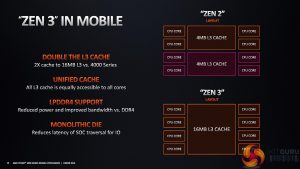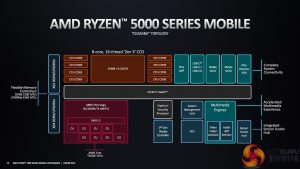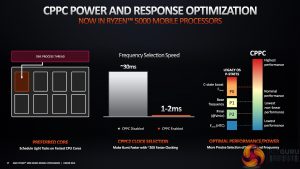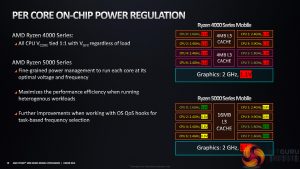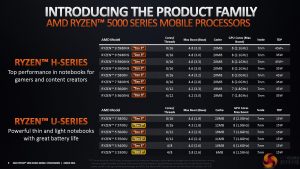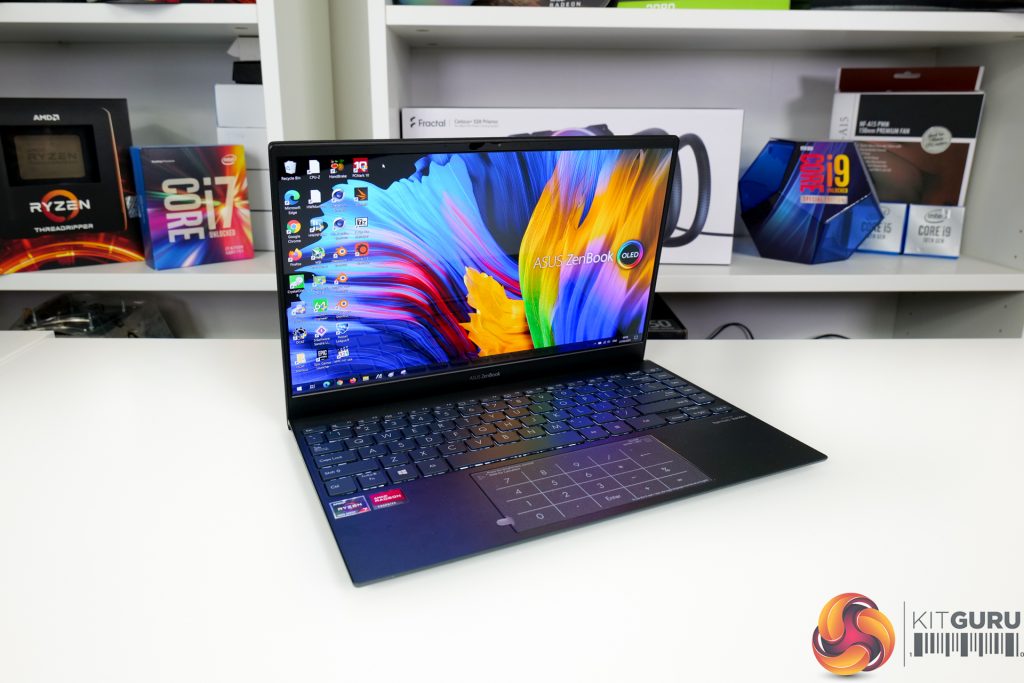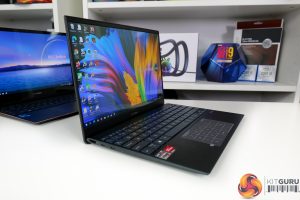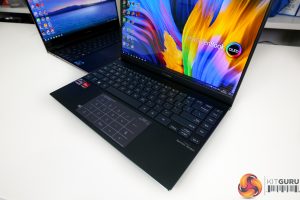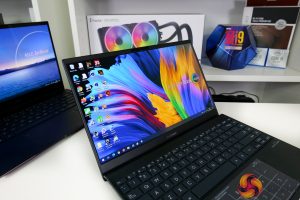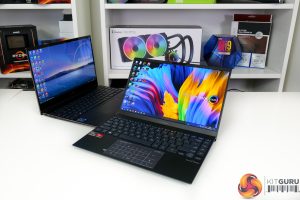The focus of our attention is the AMD Ryzen 7 5800U – Cezanne – APU. This eight-core, sixteen-thread chip is built around the Zen 3 architecture on the CPU front. That means you get 16MB of L3 cache and 4MB of L2 cache squeezed into the 15W nominal TDP.
There is, however, a configurable cTDP of 10-25W at the manufacturer discretion, according to AMD. Our sample runs in the nominal 15W TDP mode by default.
Built around 7nm TSMC FinFET technology, the single-CCX, eight-core 5800U features a 1.9GHz base clock and up to 4.4GHz for maximum boost for the CPU. That’s an increase of 100MHz base and 200MHz maximum boost versus the older Ryzen 7 4800U it replaces. Plus, you get the 8MB L3 cache increase for the 5800U versus its Zen 3 predecessor.
Somewhat disappointingly, we still get the same-old eight Vega-based compute units for the 5800U’s GPU segment. AMD does, however, bump up the 5800U’s maximum GPU boost clock to 2GHz which is a 250MHz improvement over the Ryzen 7 4800U of yesteryear. Of course, that limit will be TDP dependent, and it is perhaps unlikely we will actually see any frequency differences in the constrained 15W operating mode.
Little change for Ryzen 5000U is seen with memory support, PCIe Gen 3 (not Gen 4) lanes, and multimedia compatibility. However, AMD does highlight some improvements for Ryzen 5000U Cezanne chips in terms of new power states that should help to improve battery life.
For more details on the Ryzen 5000 Mobile APU architecture, see our review of the Ryzen 5000 launch sample ASUS ROG Flow X13 laptop. The information there is relevant as the 7nm, 180mm2, 10.7 Billion FET Ryzen 5000 Mobile SOCs are primarily differentiated by their TDP-determined clock speeds on a core-for-core basis.
One point to note is that not all Ryzen 5000U chips are Zen 3. Some of the lower-end models – the Ryzen 7 5700U, Ryzen 5 5500U, and Ryzen 3 5300U for example – are actually Zen 2-based Lucienne chips. That’s an important difference and can usually be identified by the quantity of cache in the chip you decide to purchase as Zen 3 will have a higher capacity at the comparable core count.
If we now take a brief overview of the unit itself, the ASUS ZenBook 13 OLED UM325S looks to be geared towards prosumers, heavy users, and perhaps even content creators who need an ultraportable laptop with processing grunt.
The main components are a Ryzen 7 5800U APU in the nominal 15W TDP mode, 16GB of LPDDR4-3733MHz memory, a 1TB SK Hynix NVMe SSD, a 67Whr battery, and a 13.3” Full HD 16:9 OLED display.
In the sleek – 30cm-wide by 20cm-deep chassis – you get a thickness that measures in a touch under 1.4cm. With premium enough – metal – chassis materials, that form factor translates into a 1.14kg weight that is easy to manage single-handedly. There is basically no keyboard flex, and the trackpad area is equally solid.
ASUS has also – in my opinion – nailed the ErgoLift hinge design with an approach that is generally easy to operate with a single hand, opens wide to around 150 degrees, and elevates the main body for airflow cooling enhancements.
The 13.3” display is a good-looking Full-HD 16:9 OLED panel that is VESA DisplayHDR True Black certified and has 100% DCI-P3 colour gamut. Reflections are not particularly bad on the glossy finish non-touch screen, and that is perhaps thanks to the solid 400-nit brightness rating that did a stellar job in our daily usage testing.
Slim bezels are perhaps not a trait I would associate with the UM325S; ASUS highlights an 88% screen-to-body ratio, but the top plastic bezel is large to permit for the webcam, and the sizable chunk of plastic below the screen also detracts from the overall feel of an ‘all-screen’ laptop.
Those plastic bezels are my biggest grievance with respect to the laptop’s design – they diminish an otherwise high-quality layout. But the image quality from the screen itself is very good.
Oh, and you get an IR camera that supports Windows Hello and delivers acceptable HD video quality.
Connectivity comes in the form of 5Gbps USB 3.2 Gen 1 Type-A, a micro-SD card reader, dual 10Gbps USB 3.2 Gen 2 Type-C, and full-sized 4K60-capable HDMI. ASUS also bundles USB-A to Gigabit Ethernet and USB-C to 3.5mm audio jack adapters, which are good to see.
There is no Thunderbolt support which is a growing problem for many premium AMD laptops in my opinion.
 KitGuru KitGuru.net – Tech News | Hardware News | Hardware Reviews | IOS | Mobile | Gaming | Graphics Cards
KitGuru KitGuru.net – Tech News | Hardware News | Hardware Reviews | IOS | Mobile | Gaming | Graphics Cards


